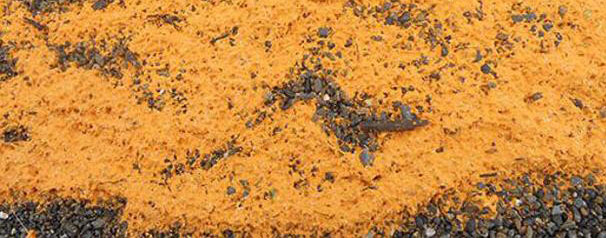 Just over a week ago we posted about a a bright orange jelly or “goo” that floated up on the beaches of Kivalina, a remote Alaskan village of just over 400 residents. At the time scientists from the National Oceanic and Atmospheric Administration (NOAA) determined that the goo was not man-made but was rather millions of microscopic invertebrate eggs, filled with fatty droplets. The only thing that they couldn’t say for sure was which specie of invertebrate the eggs were from. Now NOAA scientists have backtracked and are now saying that the “eggs” are not eggs at all but a type of fungus. And exactly which type of fungus is it? The scientists are not sure. Why aren’t we surprised?
Just over a week ago we posted about a a bright orange jelly or “goo” that floated up on the beaches of Kivalina, a remote Alaskan village of just over 400 residents. At the time scientists from the National Oceanic and Atmospheric Administration (NOAA) determined that the goo was not man-made but was rather millions of microscopic invertebrate eggs, filled with fatty droplets. The only thing that they couldn’t say for sure was which specie of invertebrate the eggs were from. Now NOAA scientists have backtracked and are now saying that the “eggs” are not eggs at all but a type of fungus. And exactly which type of fungus is it? The scientists are not sure. Why aren’t we surprised?
UPDATE: Alaska’s mysterious orange goo NOT eggs, but a fungus!
No wonder 69 percent of Americans are distrustful of scientists! If they can’t even get something as easy as animal vs. fungus right, how can we take them at their word that the earth’s climate is changing? I demand an inquiry!
Sorry… just a little upset about having to retract an earlier blog post about the mysterious orange goo turning up in the waters of Kivalina, Alaska. Scientists from NOAA put the stuff under a slide and saw eggs from an unknown crustacean with mango-colored lipid centers. But that preliminary analysis turned out to be wrong. It’s spores from a fungus, according to the NOAA’s National Ocean Service Center for Coastal Environmental Health and Biomolecular Research (phew):
“[A] team of scientists highly-specialized and equipped to analyze microbiologic phenomena such as this determined that the substance is consistent with spores from a fungi that cause rust, a disease that infects only plants causing a rust-like appearance on leaves and stems. Rust fungi reproduce to infect other plants by releasing spores which disperse often times great distances by wind and water. However, whether this spore belongs to one of the 7,800 known species of rust fungi has not yet been determined.”
